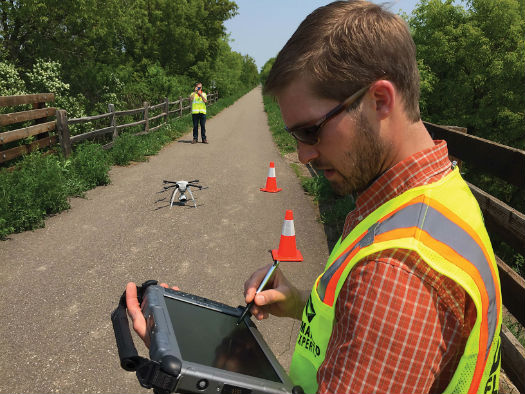
Yellowhead Helicopters and Unmanned Experts created a joint venture, Yellowhead Unmanned, earlier this year. It will pair Yellowhead’s aviation expertise and client base with Unmanned’s UAV experience, equipment, and training. Yellowhead Helicopters Photo
The mere mention of unmanned aerial vehicles (UAVs) often sparks a passionate response in the rotorcraft industry. In many a boardroom, hangar, and watering hole, concerns are being raised over everything from airspace safety, the potential for fatal accidents, and lack of regulation, to the loss of helicopter work — and jobs — to the remotely-operated aircraft.
However, at Yellowhead Helicopters in Prince George, B.C., discussions about UAVs turned to inspiration. The renowned 40-year-old Canadian helicopter operator, which serves the oil-and-gas, mining, forestry, and utility industries, is dedicated to renewing and updating their services and equipment to keep pace with their clients’ ever-changing needs. With UAV technology rapidly growing and changing, Yellowhead leadership saw an opportunity.
“There are certainly some aspects of what we currently do for our clients, as well as several things we can’t do, that could be accomplished by UAVs. The question was how to deliver that service at our level of quality and safety,” said Jacob Forman, CEO and accountable executive at Yellowhead.
Forman said several UAV operators with an impressive and deep knowledge of drone technology had approached him and some of his clients to offer their services — but none of them possessed familiarity with aviation quality and safety, something clients expect from Yellowhead.
Forman saw an opportunity to fill that aviation knowledge gap. If Yellowhead could find a way to embrace UAV technology and pair it with their expansive aviation quality and safety culture, he could expand Yellowhead’s services to its already loyal clientele.
“UAV technology is coming, and it’s coming so fast regulation can’t keep up with it,” he said. “There are so many similarities between what we do with rotorcraft and what can be done with UAVs. In some cases, there is work smaller UAVs can do that we can’t, such as sensor work. We saw an opportunity to get in on the ground floor as both UAV technology and its industry develop, rather than getting in later and trying to catch up. However, we aren’t in a position to do it all ourselves. We know helicopters, not drones.”
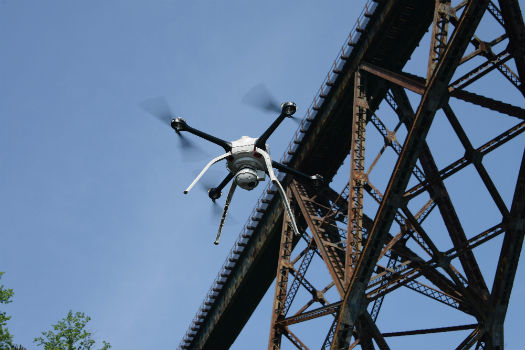
Yellowhead is aiming to expand its services to its existing clientele.
To investigate how Yellowhead might add UAV services to its repertoire, Forman sent Yellowhead director of quality and safety Marc Schoenrank to the 2014 International Conference on Intelligent Unmanned Systems in Montreal last September. What Schoenrank learned would lead to Canada’s first helicopter/UAV partnership.
“While the conference was filled with experts in drone technology who really knew their stuff, there continued to be a complete lack of operational aviation safety know-how,” Schoenrank said. “The UAV industry is so new, it doesn’t have the aviation risk management and safety history built from years of experience, accidents and close calls. Few knew about SMS [safety management systems], QA [quality assurance], training and maintenance assurance programs, or other essential pieces to a safe and successful aviation company. The question in my mind became, how do we get the aviation mindset into the drone industry?”
When worlds collide
While at the conference, Schoenrank crossed paths with Unmanned Experts Inc., a UAV training and consulting firm based in Denver, Colo. Unlike most other UAV operators, Unmanned Experts was created and run by aviation and UAV professionals with more than 35,000 hours in manned aircraft (on top of more than 25,000 hours with unmanned aircraft). They understood aviation.
Unmanned Experts offers a menu of UAV services including professional training for operators, assistance in setting up UAV programs for companies, and direct UAV services for public and private entities. In a nutshell, not only do they develop and operate their aircraft in professional contract settings, they teach agencies and companies how to set up and operate their own UAV programs.
The company is also active in helping develop regulation for the industry. Currently Unmanned Experts is working with NASA’s unmanned traffic management (UTM) project, a program to identify how manned and unmanned aircraft can safely share low-altitude airspace.
Additionally, through partnerships with engineering, software development and technology firms, Unmanned provides a full suite of services to clients similar to those of Yellowhead outside Canada. Based on the job, the company’s cameras and specialized sensors capture required data, then, utilizing its own software programs, Unmanned provides the data in useable formats for the client.
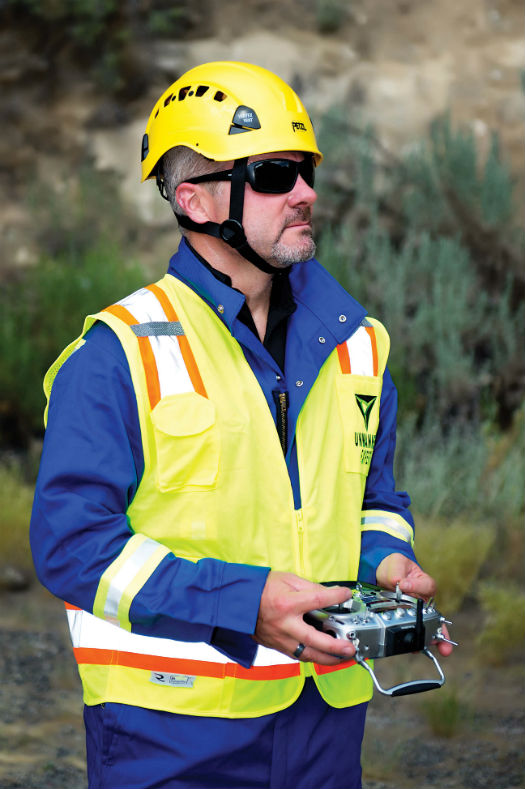
Unmanned Experts includes safety, maintenance and operations training when consulting an agency or company to set up their own UAV operation. Yellowhead Helicopters Photo
However, what fully sold Schoenrank was the fact Unmanned Experts did all of this from the aviation quality and safety perspective.
“I’d suspect drone operators will eventually be required to have operating certificates, safety and maintenance programs, operating manuals, pilot training in the general aviation realm, and for the pilots to have licenses,” Schoenrank said. “The key to managing risk in aviation is to have a human in the aircraft. You take that human out, and you’re removed from the situation. There has to be risk management and safety systems prevalent in all drone operations. What attracted us to Unmanned Experts is they had the same philosophy.”
Unmanned Experts maintains aviation safety systems in their operations and training. “I think what really attracted Yellowhead to us was our dedication to operating as an aviation company first,” said Dave Prall, chief operating officer at Unmanned Experts. “We see our drones as aircraft first. We include safety, maintenance and operations training when consulting an agency or company to set up their own UAV operations. In pilot training, we include information any pilot is required to know — weather, maintenance, airspace, regulations, preflights, etc.”
A partnership takes flight
Through a series of meetings and brainstorming sessions, the two companies identified a joint venture opportunity that would utilize the expertise of both companies in a way that would meet the needs of Yellowhead’s clients.
Earlier this year, Yellowhead Helicopters and Unmanned Experts created a joint venture, Yellowhead Unmanned. Based in Athabasca, Atla., this independent, stand-alone company is a 51 (Yellowhead)/49 (Unmanned) venture, pairing Yellowhead’s aviation expertise and loyal client base with Unmanned’s UAV experience, equipment, and training.
“We believe it’s a first,” said Prall. “It’s no secret there is friction between general aviation and UAVs, but this joint venture shows how the two can work well together, utilizing and respecting the other’s expertise.”
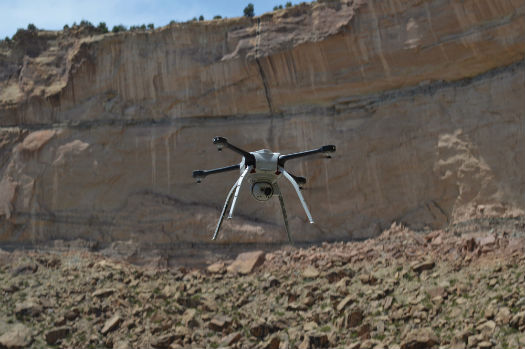
Among the missions Yellowhead Unmanned is targeting are flarestack inspections, powerline inspections, surveys, mapping, search-and-rescue, programme- try and GIS services, and filming. Yellowhead Helicopters Photo
In the joint venture, Yellowhead is working with current clients to identify additional services it can provide using UAVs, sharing information on the equipment used, data that can be gathered, and the delivered reports the clients can use. Unmanned is maintaining the latest technology, cameras, sensors and software to deliver the service while also working to help train and provide pilots to operate the UAVs.
“We’ve had a number of our pilots express interest in learning to operate the drones. We’re working on getting several of them trained,” Schoenrank said. “The drones and their equipment are small enough to travel in a helicopter. A pilot who could fly out to a site in the helicopter, and operate the drone with the sensors onboard, increases the services Yellowhead can provide.”
For Unmanned Experts, it’s also a win-win situation. “We’re really excited about this venture,” Prall said. “It opens the Canadian market to us. Yellowhead has such a strong reputation with some very large and established clients who will further expand the use of UAVs.”
Scope of work
In the UAV world, there are two kinds of aerial vehicles — line-of-sight and beyond line-of-sight. Line-of-sight UAVs remain within sight or short-range radio distance from the operator on the ground. Beyond line-of-sight vehicles can go much further, some up to several hundred kilometers (think Predator Drone), well out of sight of the operator.
Currently, Yellowhead Unmanned is focusing on operations that remain within line-of-sight and operate rotorcraft-type vehicles (as opposed to fixed-wing). Depending on how these operations go, the company may expand to line-of-sight fixed wing operations, then eventually to beyond line-of-sight operations once technology in that field develops, Forman said.
Technology is developing fast, with big changes showing up on the scene every few weeks to months. LIDAR (remote sensing technology), infrared sensors and the like, which used to be so big they needed to be on large fixed-wing drones, have gotten smaller and can now be used on rotorcraft drones, for instance. These changes are opening doors that Yellowhead Unmanned plans to fly through.
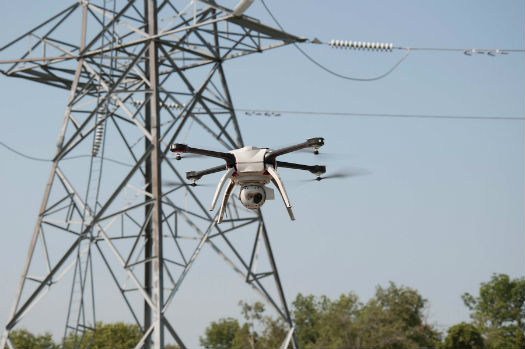
Yellowhead doesn’t foresee its UAVs replacing helicopters; rather, the company said it would open doors to things it hasn’t been able to do before. Aeryon Photo
“This partnership is not a plan to replace what helicopters do with drones,” said Schoenrank. “The technology is opening doors for us to do things we’ve not been able to do before.
For instance, flying conditions could be bad around a wildland fire, and a helicopter couldn’t go in and map it — but a drone can. The conversation is around reduced risk and increased accuracy.”
Other UAV operations Yellowhead Unmanned is targeting include flarestack inspections, powerline inspections, surveys, mapping, search-and-rescue, programmetry and GIS services, and filming.
Currently Yellowhead Unmanned is talking with Yellowhead customers about expanded services it can provide, both gathering input on need, and laying groundwork for future contracts. “We work seasonally and it’s too late in the season to sign on for additional work in most cases,” Schoenrank said. “However, this spring we began talking to our clients in oil-and-gas, mining, powerline, hydroelectric, forestry and wildland fire to develop ways we can use this new technology to meet their needs.”
As the company is still in its infancy, no direct contract work has been commissioned to date. However, testing will continue through the summer, with plans to start putting the UAVs to work in spring 2016 — or even sooner if an opportunity arises.





